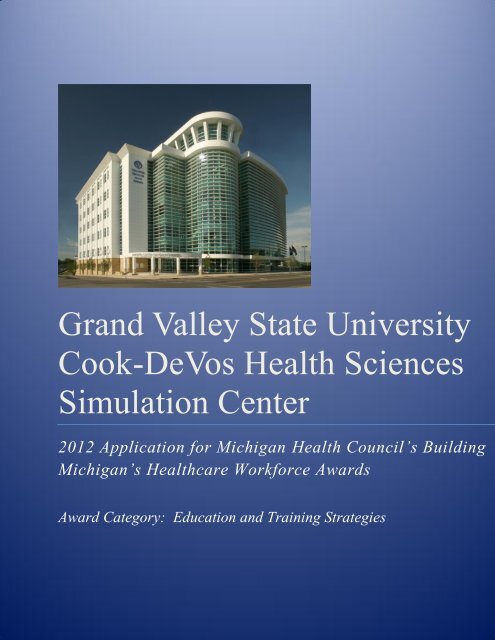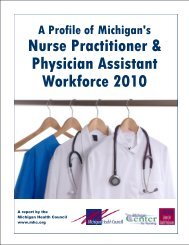Grand Valley State University Cook-DeVos Health Sciences Simulation Center
Grand Valley State University Cook-DeVos Health Sciences ...
Grand Valley State University Cook-DeVos Health Sciences ...
Create successful ePaper yourself
Turn your PDF publications into a flip-book with our unique Google optimized e-Paper software.
<strong>Grand</strong> <strong>Valley</strong> <strong>State</strong> <strong>University</strong><strong>Cook</strong>-<strong>DeVos</strong> <strong>Health</strong> <strong>Sciences</strong><strong>Simulation</strong> <strong>Center</strong>2012 Application for Michigan <strong>Health</strong> Council’s BuildingMichigan’s <strong>Health</strong>care Workforce AwardsAward Category: Education and Training Strategies
Table of ContentsI. Michigan <strong>Health</strong> Council Submission Form ......................................................... 2II. Abstract ................................................................................................................................................ 3III. Program Goals .................................................................................................................................. 3IV. Program Design and Implementation .................................................................... 5V. Assessment and Outcomes .......................................................................................................... 9VI. Sustainability ................................................................................................................................... 10Attachment A – PIPES BrochureAttachment B – CHS <strong>Simulation</strong> <strong>Center</strong> Strategic PlanAttachment C – College of <strong>Health</strong> Professions Letter of RecommendationI.1
Building Michigan’s <strong>Health</strong>care Workforce AwardMichigan <strong>Health</strong> CouncilSubmission Form1. Award Category: Education and Training Strategies2. Organization and Contact Information:<strong>Grand</strong> <strong>Valley</strong> <strong>State</strong> <strong>University</strong>CHS <strong>Simulation</strong> <strong>Center</strong>301 Michigan Street, NE<strong>Cook</strong>-<strong>DeVos</strong> <strong>Center</strong> for <strong>Health</strong> <strong>Sciences</strong>Suite 500<strong>Grand</strong> Rapids, MI 49503Jean Nagelkerk PhD, FNP, RNVice Provost for <strong>Health</strong>Phone: (616) 331-2729Fax: (616) 331-5640viceprovostforhealth@gvsu.edu3. Participating in Michigan <strong>Health</strong> Council activities to promote bestpractices:Yes, The Michigan <strong>Health</strong> Council may publish the abstract of our program, withour contact information, in printed materials for distribution by the Michigan <strong>Health</strong>Council.Yes, The Michigan <strong>Health</strong> Council may publish the abstract of our program, withour contact information, on its website.2
II.AbstractAs a founding member of the West Michigan Interprofessional Education Initiative,<strong>Grand</strong> <strong>Valley</strong> <strong>State</strong> <strong>University</strong> (GVSU) holds a firm commitment to interprofessionalhealthcare in West Michigan. The GVSU <strong>Cook</strong>-<strong>DeVos</strong> <strong>Health</strong> <strong>Sciences</strong> (CHS)<strong>Simulation</strong> <strong>Center</strong> shares this commitment and is an integral part of the preparatory forceleading the region in promoting the integration of interprofessional healthcare throughinnovative methodologies designed to educate and train students from health-relatedprofessions.The CHS <strong>Simulation</strong> <strong>Center</strong> transports healthcare education and practice from a “silo”environment to a collaborative “team” delivery system making optimal use of theknowledge and skills of each professional discipline and ensuring that our healthcareprofessionals of tomorrow are well versed in integrating practices and working within aninterprofessional framework prior to graduation.In doing so, the CHS <strong>Simulation</strong> <strong>Center</strong> aligns with the <strong>University</strong> to meet its mostimportant mission – Educating students to shape their lives, their professions and theirsocieties.III.Program GoalsIn 2003 with a growing enrollment and an obligation as a university to educate thehealthcare workers of the future GVSU expanded and built the <strong>Cook</strong>-<strong>DeVos</strong> <strong>Center</strong> for<strong>Health</strong> <strong>Sciences</strong> on the Medical Mile in <strong>Grand</strong> Rapids, Michigan. It was during theconceptual phase of the expansion project that the CHS <strong>Simulation</strong> <strong>Center</strong> was brought tofruition. At the time, a landmark report from the Institute of Medicine (IOM) stated, “Inits current form, habits, and environment, American healthcare is incapable of providingthe public with the quality healthcare it expects and deserves.” An earlier IOM reportestimated that between 44,000 and 98,000 people were dying in American hospitals eachyear due to medical errors at a cost of approximately $38 billion. With a need for nationalhealthcare reform due to patient safety issues, fragmentation of healthcare delivery, risinghealthcare costs and inadequate technological infrastructure for sharing information theIOM reported the importance of interprofessional education and practice in providing3
quality patient care. This interprofessional method would in hope transform healthcareeducation and practice from an autonomous authoritarian approach to a culture of patientcentered,cost effective, collaborative teamwork focused on effective communication andshared responsibility for patient outcomes.In order for the university to contribute to the foreseeable change required in healthcaredelivery it was apparent and crucial that GVSU identify additional strategies toincorporate and adopt a model of interprofessional education and practice acrosscurriculums. Therefore, under the vision of the Provost and the leadership of the ViceProvost for <strong>Health</strong> the centralized CHS <strong>Simulation</strong> <strong>Center</strong> was created to encourageinterprofessional education at the <strong>University</strong> and practice in the community.The greatest challenge of creating a consolidated simulation center was the culture ofchange it caused. No longer were the <strong>University</strong>’s health related academic departmentsgoing to have their own designated simulation space for just their units students andfaculty. To address this challenge faculty and student input was encouraged. The<strong>Simulation</strong> Advisory Committee was convened and comprised of faculty and staff fromthe GVSU College of <strong>Health</strong> Professionals, the Kirkhof College of Nursing and the CHS<strong>Simulation</strong> <strong>Center</strong>. The Advisory Committee’s mission was and remains today to supportfaculty, staff and the community in the use of simulation in education and research.It was collectively decided that the CHS <strong>Simulation</strong> <strong>Center</strong> would be interprofessional innature and designed to incorporate the essential staff, space and state of the art equipmentneeded to support the synergistic interprofessional education of the approximately 5000students from health affiliated programs at the <strong>University</strong>.The mission of the CHS <strong>Simulation</strong> <strong>Center</strong> remains to promote interprofessionalhealthcare delivery by enhancing professional competencies through a safe, interactiveand engaging learning environment.The vision of the CHS <strong>Simulation</strong> <strong>Center</strong> states that by focusing on interprofessionalhealth education as a model for collaboration and lifelong learning, the CHS <strong>Simulation</strong><strong>Center</strong> will lead the region in enhancing patient safety and the quality of healthcare,through the use of innovative simulation programs. The <strong>Simulation</strong> <strong>Center</strong> will meet thecurrent and ongoing needs of the university and partner with the local healthcare industry,4
the community and the state. The <strong>Simulation</strong> <strong>Center</strong> will attract students and supportGVSU as a major provider of healthcare professionals in the region and nation.IV.Program Design and ImplementationWith the combined support of the <strong>University</strong>, community donors and grant funding theCHS <strong>Simulation</strong> <strong>Center</strong> housed within the 217,000 square foot <strong>Cook</strong>-<strong>DeVos</strong> <strong>Center</strong> for<strong>Health</strong> <strong>Sciences</strong> building was constructed and opened in 2007 to service faculty andstudents from the following academic programs; allied health, medical laboratory science,nursing, occupational therapy, physician assistant, physical therapy, radiation and imagingsciences, speech language pathology and therapeutic recreation. To date, the CHS<strong>Simulation</strong> <strong>Center</strong> includes the following features and technology:• The Learning Resource <strong>Center</strong>• Assessment, Skills and Gait Analysis Labs• Hospital, Model Patient and Model Living <strong>Simulation</strong> Suites• Microbiology and Clinical Lab• Radiation and Imaging <strong>Sciences</strong> <strong>Simulation</strong> Suite• Digital Learning Library• Education Management Solutions Arcadia Software System• Standard Patient Program• Human Patient Simulator• Emergency Care Simulator• SimMan, SimBaby, and SimNewB(A virtual tour is available at: http://www.gvsu.edu/simulation/about-our-facility-7.htm )To meet the needs of the academic units the CHS <strong>Simulation</strong> <strong>Center</strong> is staffed with twopart-time and eight full-time dedicated staff members in addition to approximately fifteenfinancially compensated student Lab Assistants per semester. The following is a copy ofthe CHS <strong>Simulation</strong> <strong>Center</strong> organizational chart.5
CHS <strong>Simulation</strong> <strong>Center</strong> Organizational ChartProvost and VicePresident forAcademic Affairs<strong>Simulation</strong> AdvisoryCommittee(SAC)Assistant Director of<strong>Simulation</strong>Vice Provost for <strong>Health</strong>Director of <strong>Simulation</strong>Associate Vice PresidentAcademic AffairsEquipment andTechnicalSupportManager<strong>Simulation</strong>AssistantStandardPatientProgramCoordinatorCHS LabSupervisorLearningResourceCoordinator<strong>Simulation</strong>InstructionalDesignerReport StructureLine of Communication - - - - - - - -LaboratoryAssistants(Student workers)Multimedia/TechnologySpecialist6
The CHS <strong>Simulation</strong> <strong>Center</strong> team’s primary function is to assist faculty to create powerfuleducational experiences through expertise multimedia instructional design in realisticenvironments within the state-of-the-art <strong>Simulation</strong> <strong>Center</strong> for students, healthprofessionals and researchers to learn, collaborate and demonstrate skills using medicalmannequins, cutting-edge technology and trained simulated patients. In addition, the<strong>Simulation</strong> <strong>Center</strong> team provides experienced assistance for faculty to enhance thedebriefing component of the simulated experience whereby the healthcare team canreexamine the simulated clinical encounter to foster the development of clinical reasoning,critical thinking, judgment skills and communication through the reflective learningprocess.The management of scheduling and designing simulated educational events is organizedby the procedure of requiring faculty to first submit their simulation event requests eachsemester via email to the Director of <strong>Simulation</strong> by a preset date prior to the start of eachsemester. Requests are placed on the electronic <strong>Simulation</strong> <strong>Center</strong> calendar on a firstcome first served basis. Faculty requests may come in the form of an interprofessionalsimulation where faculty members from different academic disciplines prearrange andconceive a simulated experience that they would like to create incorporating students fromtheir programs. Or like the majority of faculty requests, in the form which are specific totheir academic discipline only. Faculty are required to include the learning objectives forstudents, the date and time for the event, the participating student’s academicdepartment(s), the preferred simulation suite or lab, and a list of any specific equipmentrequired. When subsequent faculty simulation requests are received that request a specificdate, time and simulation suite that has already been booked the Director of <strong>Simulation</strong>explores options to incorporate that request with another simulation event to create aninterprofessional experience at the same date and time. If it is not feasible, the request isdenied and alternate dates and times are offered to schedule the requested simulation. Toaccommodate every simulation request each semester the simulation team often worksunconventional hours; early morning, evenings and weekends.Once all of the simulation event requests are received for the semester the CHS<strong>Simulation</strong> <strong>Center</strong> team meets to review each request and discuss options for design andinterprofessional collaboration. The core challenge in creating interprofessionalsimulations is time. Interprofessional simulation take greater staff and faculty time todesign and it takes additional effort to coordinate the simulation event with the schedulesof students and faculty from different academic units. Even with the time deterrent the7
CHS <strong>Simulation</strong> <strong>Center</strong> team ensures that at least one interprofessional simulation eventoccurs each semester.The next step in the process involves the <strong>Simulation</strong> <strong>Center</strong> team members meeting withfaculty to develop the instructional design of the simulations to meet the stated objectives.The simulations are created and stored for reuse in the Education Management SolutionsArcadia software system. Some faculty will request to use scripted simulation scenarioswritten by companies that offer this service for a fee. Unfortunately, the purchasedscenarios are not interprofessional and have to be modified in order to use them in aninterprofessional manner. The digital audio-video recording Arcadia software systemautomates the entire CHS <strong>Simulation</strong> <strong>Center</strong> workflow from scenario developmentthrough to post scenario analysis and debriefing.In addition to the promotion of interprofessional education within the <strong>University</strong> the CHS<strong>Simulation</strong> <strong>Center</strong> team also works to stimulate interprofessional practice in thecommunity by; hosting guest lectures on simulation practices, providing simulationworkshops and working on initiatives created by the West Michigan InterprofessionalEducation Initiative.The West Michigan Interprofessional Education Initiative is a partnership between GVSU,Michigan <strong>State</strong> <strong>University</strong> College of Human Medicine and <strong>Grand</strong> Rapids MedicalEducation and Research <strong>Center</strong>, their objective is to identify ways that the partners candevelop collaborative, innovative and interprofessional initiatives across disciplines,learning institutions and healthcare systems. The CHS <strong>Simulation</strong> <strong>Center</strong> team’s workwith the West Michigan Interprofessional Education Initiative includes; creating andimplementing training modules designed to improve the safety and quality of healthcarefor the Safety Culture Transformation Study conducted at Helen <strong>DeVos</strong> Children’sHospital, participation in the champion workgroups, involvement in the annualinterprofessional conference and oversight of the west Michigan student organizationPIPES (See Attachment B). PIPES is an acronym for Promoting InterprofessionalEducation for Students. PIPES was established in 2010 to provide an additional venue forstudents to learn the perspectives of other health professions while simultaneouslydeveloping professional identities for their own future roles. The 111 current membersinclude students from GVSU’s nursing, physical therapy, physician assistant, medicallaboratory sciences, speech and language pathology, health administration and biomedical8
sciences programs, and Michigan <strong>State</strong> <strong>University</strong>’s College of Human Medicine. DuringPIPES meetings a health professional from the community is often invited to talk abouttheir specific role in healthcare which is followed by a facilitated student discussion.V.Assessment and OutcomesThe CHS <strong>Simulation</strong> <strong>Center</strong> staff and endeavors are evaluated in several ways. Firststudents that participate in simulation events are evaluated by faculty on their skills andcomprehension based on the objectives of the simulation event. The <strong>Simulation</strong> <strong>Center</strong>staff are required to participate in the electronic Performance Development Programannually which is a communication program for staff members and supervisors to helpthem understand their roles, continue to learn and participate in the improvement ofGVSU. In addition, the Vice Provost for <strong>Health</strong>’s personal performance is reviewedannually incorporating anonymous feedback from faculty and staff throughout the<strong>University</strong>.The CHS <strong>Simulation</strong> <strong>Center</strong> has also developed a strategic plan with objectives,measurable goals and specific actions designated to meet those goals by 2015 (Seeattachment B). The strategic plan is reviewed annually by all members of the simulationteam and leadership. The goals of the CHS <strong>Simulation</strong> <strong>Center</strong> strategic plan are:Goal #1: Provide high quality simulation services to support GVSU program curriculumsand educational excellence.Goal #2: Become the model simulation center for interprofessional healthcare educationin the region.Goal #3: Expand external community collaboration and partnershipsThe CHS <strong>Simulation</strong> <strong>Center</strong> is well on their way to meeting all of their 2015 goals. Forexample, to look back at just the 2011/2012 fall and winter semesters the CHS <strong>Simulation</strong><strong>Center</strong> created 80 simulation events (3 of which were interprofessional) with 2164 studentparticipants. There were 179 standard patient events with over 1693 student participants,425 lab events, 750 hours of video produced and 254 hours of streaming video completed.9
In 2011 the CHS <strong>Simulation</strong> <strong>Center</strong> hosted Suzan Kardong-Edgren PhD, RN, AssistantProfessor at Washington <strong>State</strong> <strong>University</strong>, a guest lecturer on “<strong>Simulation</strong>: From thePioneers to the Future”. On June 14 th , 2012 the CHS <strong>Simulation</strong> <strong>Center</strong> hosted theMedical Mile <strong>Simulation</strong> Day, a workshop free to anyone interested in healthcaresimulation and education. Every summer the CHS <strong>Simulation</strong> team also assists with theCollege of <strong>Health</strong> Profession’s Summer <strong>Health</strong> Activities and Professions Exploration(sHaPe). sHaPe is a free one-week day program intended to introduce middle schoolstudents to the health professions.In addition to the work with the West Michigan Interprofessional Education Initiative thispast year, the CHS <strong>Simulation</strong> <strong>Center</strong> also produced training modules for the WoundedWarrior Project, a collaborative program between GVSU and Mary Free BedRehabilitation Hospital, with funding from the United <strong>State</strong>s Department of Defense tohelp rehabilitate soldiers who suffered a traumatic brain injury while on active duty.The creation of the CHS <strong>Simulation</strong> <strong>Center</strong> has had a positive impact on the <strong>University</strong>.The cost of educating students is expensive, but the centralization of the simulation centerpermits financial allocations for simulation needs between departments to be equalizedand material resources shared, limiting the need for duplicate equipment and staffingresources for academic disciplines. And although GVSU is still in the early phase ofproducing health professionals well versed in interprofessional practice, hopefully withtime, the impact GVSU students trained through the use of interprofessionalmethodologies will have an effective impact on the overall system of healthcare delivery.VI.SustainabilitySince the CHS <strong>Simulation</strong> <strong>Center</strong> is vital to the educational pursuits of the College of<strong>Health</strong> Professions and the Kirkhof College of Nursing the <strong>University</strong> supports thefunction of the CHS <strong>Simulation</strong> <strong>Center</strong> and allocates close to three quarters of a milliondollars in annual budgeting for the operational aspects of the CHS <strong>Simulation</strong> <strong>Center</strong>.The sustainability of the CHS <strong>Simulation</strong> <strong>Center</strong> is particularly strong, especially in lightof current difficulties across the country with securing clinical placement sites for students10
in health related programs. Public universities, private institutions and communitycolleges are all contending to acquire those finite clinical placements for their students.Due to this limitation, educators are exploring alternative means of providing “real world”opportunities for students to practice their professional clinical skills. One of the viableoptions is thought to be through the use of simulation. Currently, The National Councilof <strong>State</strong> Boards of Nursing is conducting a National <strong>Simulation</strong> Study to examine the roleand outcomes of simulation as a replacement for hours spent by nursing students intraditional clinical settings. The data collection for the study is slated to be completed byDecember 31, 2014.In order to be prepared to meet future educational demands and continue to providegenuine “real world” simulated experiences requires the CHS <strong>Simulation</strong> <strong>Center</strong> to remainup to date with the medical technology and best practice techniques. Through support ofthe <strong>University</strong>, the generosity of community donors and grant funding the CHS<strong>Simulation</strong> <strong>Center</strong> is able to continuously improve the facility and their interprofessionalfocus. The CHS <strong>Simulation</strong> team bases their endeavors for new equipment and initiativesby; following recommendations of the Institute of Medicine, routinely seeking facultyinput, adhering to advice given by the GVSU <strong>Simulation</strong> Advisory Committee andremaining active members of the Society for <strong>Simulation</strong> in <strong>Health</strong>care (SSH) and the WestMichigan Interprofessional Education Initiative.In conclusion, the CHS <strong>Simulation</strong> <strong>Center</strong> team believes interprofessional healthcaredelivery is essential to quality patient care. The CHS <strong>Simulation</strong> <strong>Center</strong> team has made ittheir responsibility and daily work to infuse innovate interprofessional education andtraining strategies with simulation to positively transform the way healthcare is delivered.Recognition of the CHS <strong>Simulation</strong> <strong>Center</strong> initiatives by the Michigan <strong>Health</strong> Councilwould not only be a great honor, but an extraordinary opportunity to showcaseinterprofessional education in simulation and its potential influence on providing quality,affordable and safe patient care.11




